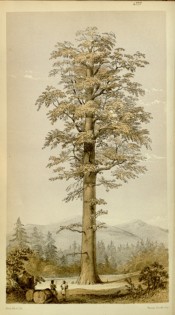Sequoiadendron giganteum (Lindl.) J.Buchholz
Large tree with deeply furrowed, reddish-brown bark, the leaves awl-shaped, bright green and spirally-arranged, of conical habit when young, the branches more widely spaced and down-swept when mature. To 90m or more. [RHSD, Hortus, Hilliers’].
Horticultural & Botanical History
Introduced to Britain in 1851. ‘Of late the curiosity of the public, as well as the botanist, has been excited by a discovery of Mr. William Lobb, of a coniferous tree in the interior of California, of a most gigantic size, measuring 300 feet and more in height, and from 10 to 20 feet in the diameter. [BM t.4777-4778/1851]. John Lindley wrote of it: ‘This magnificent tree, from its extraordinary height and large dimensions, may be termed the monarch of the Californian forest. It inhabits a solitary district on the elevated slopes of the Sierra Nevada, near the head-waters of the Stanislau and San Antonio rivers, in latitude 38 deg. N., longitude 1290 deg. 10’ W., at an elevation of 5000 feet from the level of the sea. From eighty to ninety trees exist, all within the circuit of a mile, and these varying from 250 feet to 320 feet in height, and from ten to twenty feet in the diameter of the trunk. Their manner of growth is much like that of Sequoia (Taxodium) sempervirens; some are solitary, some are in pairs, while some, and not unfrequently, stand three and four together. A tree recently felled measured about 300 feet in length, with a diameter, including bark, 29 feet 2 inches, at five feet from the ground; at eighteen feet from the ground it was 14 feet 6 inches through; at 100 feet from the ground, fourteen feet; and at 200 feet from the round, five feet five inches. The bark is of a pale cinnamon-brown, and from twelve to fifteen inches in thickness. The branchlets are round, somewhat pendent, and resembling a Cypress or Juniper. The leaves are pale grass-green; those of the young trees are spreading, with a sharp, acuminate point. The cones are about two and a half inches long, and two inches across the thickest part. The trunk of the tree in question was perfectly solid from the sap-wood to the centre, and, judging by the number of concentric rings, its age has been estimated at 3000 years. The wood is light, soft, and of a reddish colour, like Redwood (or Taxodium sempervivum [sic]). Of this vegetable monster, twenty-one feet of the bark, from the lower part of the trunk, has been put up in the natural form, at San Francisco, for exhibition; it there forms a spacious carpeted room, and contains a piano, and seats for forty persons. On one occasion, a hundred and forty children were admitted without inconvenience.’ [GC p.819, p.823/1853, quoted in Curtis’s Botanical Magazine].
History at Camden Park
The only reference to this tree is in a letter from Isabella Bowman to William Macarthur on February 28th 1856: ‘Aunt Emmeline [William’s youngest sister] sent me a few seeds of Wellingtonia gigantean (or Mammoth tree) last week and Mr. Ferguson [Francis Ferguson, head gardener] says it is a very rare and valuable tree.’ [MP A2953]. It seems likely that the seeds were sown but I have found no other evidence of this tree being planted in the garden.
Notes
Published Aug 07, 2009 - 04:49 PM | Last updated Jul 31, 2010 - 04:47 PM
| Family | Taxodiaceae |
|---|---|
| Category | |
| Region of origin | California |
| Synonyms |
|
| Common Name | Wellingtonia, Mammoth tree, The big tree |
| Name in the Camden Park Record | Wellingtonia gigantean |
| Confidence level | high |
